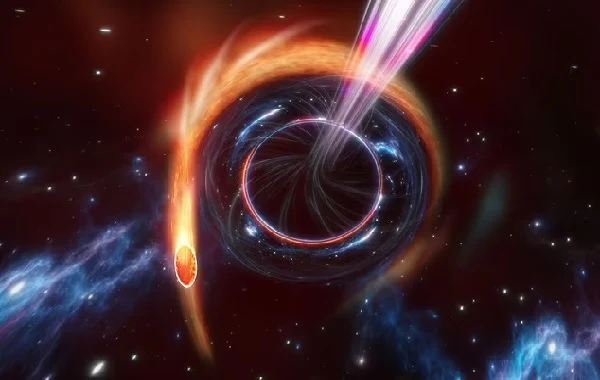A star being "squeezed like a toothpaste tube" by a supermassive black hole has produced a mysteriously brilliant flash that emitted more light than 1,000 TRILLION suns, according to research.
A mysteriously brilliant flash in the sky was caused by a supermassive black hole "squeezing" a distant star like a toothpaste tube, according to research.
When astronomers at the Zwicky Transient Facility in California spotted a flash in February that produced more light than a trillion suns, they were stunned.
A tidal disruption event (TDE), in which a star gets a little too close to a black hole and is ripped apart by its gravitational pull, is now the cause of the light, the research team says.
It is the brightest TDE ever seen from Earth and has been described as one of the most violent events in the cosmos, with temperatures exceeding 30,000°C (54,000°F).
The event, AT2022cmc, was the most distant TDE ever discovered, occurring more than eight billion light-years away, or more than halfway across the universe.
Its data collection could provide new insights into the growth and nutritional needs of supermassive black holes.
A "jetted TDE," or flash of light, was first seen during a regular all-sky scan and was later determined to be the source of the flash.
After the star was obliterated, a stream of material extending along the spin axis of the black hole was shot out at nearly the speed of light.
The X-ray energy released was absorbed by the dust surrounding the black hole and then re-emitted as infrared radiation, radio waves, and visible light.
Despite being so far away, the jet's remarkable brightness and orientation toward Earth allowed instruments around the world to capture it in incredible detail.
These included the European Southern Observatory's Very Large Telescope in Chile and the Liverpool Telescope in Spain.
We have only seen a small number of these jetted TDE's and they remain highly exotic and poorly understood phenomena," said Nial Tanvir of the University of Leicester, who worked on the research.
After the star was annihilated, a stream of matter extending along the spin axis of the black hole shot out of it at nearly the speed of light. This produced X-rays that were absorbed by the dust surrounding the black hole and then re-emitted as infrared radiation, radio waves and visible light.
A co-author from Liverpool John Moores University, Dr. Daniel Perley, called AT2022cmc a type of TDE that is "extraordinary" and "does not seem to fit any known type of celestial source.
Most explosions are either much faster, much slower, or much bluer than statistics would suggest, he said.
The star is often torn apart by strong gravitational forces, becoming a superheated disk of gas that eventually disappears into the black hole.
But in this case, something happened that ejected matter back into space almost as fast as light.
We compare it to a tube of toothpaste that has been unexpectedly squeezed in the middle, causing the toothpaste to come out of both ends.
The powerful optical, radio, and X-ray emission is then produced as the material interacts with the surrounding atmosphere.
According to co-author and MIT astronomer Dr. Dheeraj Pasham, the study team was able to "capture this event at the very beginning, within a week of the black hole starting to feed on the star.
It was also the first time an optically detectable jetting TDE has been made.
"Until now, the few known jetted TDE's were originally discovered using high-energy gamma-ray and X-ray observatories," said Dr. Perley.
When AT2022cmc was first discovered, scientists used the NICER (New Instrument for Compositional Research) X-ray telescope on the International Space Station to study it.
They discovered that the source of the radiation was 100 times more powerful than the most powerful ever identified.
As brilliant as they are, falling stars can only produce so much light, according to Dr. Benjamin Gompertz of the University of Birmingham, who led the research.
"We realized that something really gigantic must be powering AT 2022cmc, since it was so brilliant and lasted so long - a supermassive black hole," the author said.
His team concluded that the destruction of the star caused a vortex of material to fall into the black hole, causing the intense X-ray activity.
According to Dr. Pasham, it is likely devouring the star at a rate of half the mass of the Sun per year.
The results of the study of AT2022cmc were published today in two journals, Nature and Nature Astronomy.
It has been well over a decade since a TDE has flown, and scientists are still puzzled as to why some TDEs fly and others do not.
The speed at which the star's material spins around the black hole as it is consumed is thought to have something to do with it, and a particularly fast spin could be driving the brilliant jets.
Astronomers believe they may be able to see more TDEs and find some answers as more powerful telescopes are deployed.
We expect to see many more of these TDEs in the future," said co-author and MIT professor Dr. Matteo Lucchini.
Then we may finally be able to explain how black holes produce these very powerful jets.

